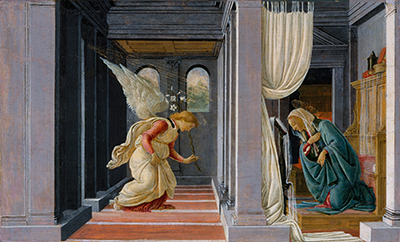This depiction of The Annunciation by Sandro Botticelli has a loose date of circa 1485-92 and is amongst his finest work on this theme
This tempera and gold on wood can now be found at the Metropolitan Museum of Art in New York, a city which now boasts amongst the best collections of art in the world. It is, however, amongst his smallest paintings, being just 19cm by 31cm.
Botticelli produced several twists on this theme, including Cestello Annunciation and another fresco titled The Annunciation from around the same time. There are several reasons for why he would have revisited this topic so frequently, with the main reason being that his customers would have requested it specifically on several occasions.
The use of linear perspective across the background in this painting was a relatively new concept within the art world, and just one of a number of developments made in the Early Renaissance. Botticelli took great care to accurately reproduce architectural scenes within his work, normally as background additions.
This fresco is believed to have been added to the Robert Lehman Collection in around 1975 and is one of the stand out pieces. There are some clues as to the working methods of Botticelli remaining on this fresco's surface, small lines which indicate experimentation and amendments. The architectural angles would have been difficult to achieve effectively, thus requiring several attempts. See also the famous work of Annunciation by Leonardo da Vinci, plus Sandro Botticelli also gave us Annunciation and Cestello Annunciation.
The pillars used in this painting do serve more of a purpose than just scenery, separating the two figures from each other. Virgin and the archangel Gabriel are placed on opposite sides of the composition. The overall structure to this painting is particularly complicated and this was common towards the end of Botticelli's career, at a time when he was at his most confident and ambitious.
This fresco is known to have been part of the Barberini collection in the seventeenth century so will have been on display in Rome at that time.




